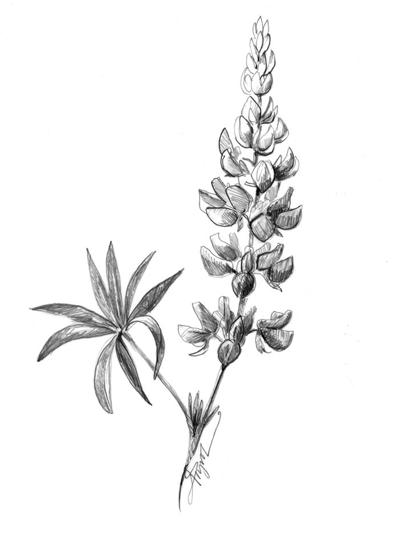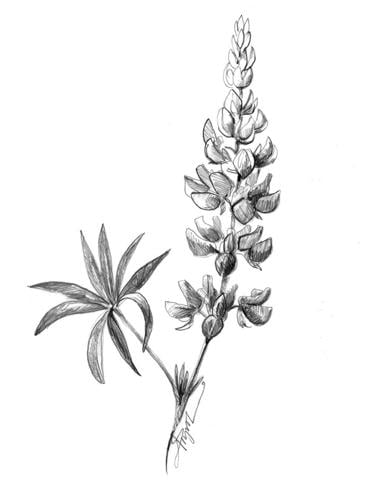Lupine is one of the most spectacular flowers of early summer, painting long stretches of roadside with shades of purple and blue. Thanks to this tall, showy plant, even a stop-and-go drive to Boston’s Logan Airport has its moments of beauty (as I recently had occasion to observe). Full sun and dry, sandy soil are just right for lupine.
Although many people don’t know it, the lupine we typically see in the Northeast is “not from around here.” It’s a non-native plant that was imported to eastern gardens from parts of the western U.S. and escaped cultivation. Our native lupine is similar, but it is seen far less often and is, unfortunately, in regional decline.
Native lupine, also known as sundial lupine, is Lupinus perennis. According to New Hampshire’s state botanist William Nichols, the Granite State lists 29 occurrences of wild lupine, 14 being historical (not documented in the past 20 years). The other 15 occurrences are extant, showing up in natural and managed open areas such as the pine/scrub oak barren near Concord’s municipal airport. In large part because of lupine’s critical role in the life of a federally endangered butterfly, there has been a two-decade-long effort to restore the pine barren habitat in Concord. The resulting return of the Karner blue butterfly is a well-publicized success story.
Wild and non-native lupine differ mostly in scale. Non-native Lupinus polyphyllus (commonly known as garden, blue-pod, or large-leafed lupine), stands 3 to 6 feet tall and has 11-17 palmate leaflets per stalk. Its seedpods are 2 inches long, with each one containing up to 9 seeds. The flower spikes, or racemes, are about a foot long. Native lupine is more modest, standing 2 feet tall, and has seven to 11 leaflets. (The palmate leaves orient themselves in the direction of the sun, leading to the name “sundial.”) Its small, downy seed pods contain three seeds each, and the blue, pink, and white flower clusters are up to 8 inches long.
For many people, especially those who grew up in Maine, the word lupine is synonymous with the name “Miss Rumphius.” The beautifully illustrated book by Barbara Cooney was based on a real-life “lupine lady” who scattered the seeds from her pockets and car windows. It might not be entirely the lupine lady’s fault, but L. polyphyllus has taken root throughout the Midwest, Northeast, and eastern Canada. At Acadia National Park, botanists attempted to eradicate the plant, but visitors protested so vociferously that the effort was halted.
Native may be better, but non-native lupine isn’t all bad. Like other members of the pea family, it is a nitrogen-fixer, helping to restore depleted soil. Its strong taproot helps to control erosion. Furthermore, bees, hummingbirds, and other pollinators couldn’t care less about the ancestral origin of their lupine.
Non-native lupine also happens to be an inspiration for artists and a boon to the tourist industry. One of the most popular lupine locations is Sugar Hill, N.H., where the 26th annual Fields of Lupine Festival took place in June. The lupine field on Sunset Hill Road, on land protected by the Ammonoosuc Conservation Trust, is one of the most photographed scenic vistas in the state, if not New England. The Franconia Range makes a pretty nice background for oceans of purple flowers. Albany, New York, and Stonington, Maine also have lupine festivals, and there may well be others.
In mid-June, I made a field trip to see wild lupine in the now-heavily-managed Concord pine barren habitat. I expected the area to look barren, but it is green and lovely and smells of sweetfern. Not more than 10 yards along the sandy path that winds through the easement, I began seeing the native lupine, and immediately saw a tiny, fluttering Karner blue butterfly. I saw so many butterflies, I soon lost count. And then I saw something else (thanks to a chance encounter with two biologists studying native bees), which I did not expect ever to see – something small, yet wondrous. At the base of a small lupine leaflet was a tiny white speck: the egg of a Karner blue butterfly. Even more than the adult butterflies, it seemed a symbol of hope.
Laurie D. Morrissey is a writer in Hopkinton, New Hampshire. The illustration for this column was drawn by Adelaide Tyrol. The Outside Story is assigned and edited by Northern Woodlands magazine (www.northernwoodlands.org) and sponsored by the Wellborn Ecology Fund of the New Hampshire Charitable Foundation (wellborn@nhcf.org).





















(0) comments
Welcome to the discussion.
Log In
Keep it clean. Please avoid obscene, vulgar, lewd, racist or sexual language.
PLEASE TURN OFF YOUR CAPS LOCK.
Don't threaten. Threats of harming another person will not be tolerated.
Be truthful. Don't knowingly lie about anyone or anything.
Be nice. No racism, sexism or any sort of -ism that is degrading to another person.
Be proactive. Use the "Report" link on each comment to let us know of abusive posts.
Share with us. We'd love to hear eyewitness accounts, the history behind an article.